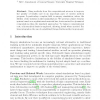Free Online Productivity Tools
i2Speak
i2Symbol
i2OCR
iTex2Img
iWeb2Print
iWeb2Shot
i2Type
iPdf2Split
iPdf2Merge
i2Bopomofo
i2Arabic
i2Style
i2Image
i2PDF
iLatex2Rtf
Sci2ools
113
Voted
MICCAI
2003
Springer
2003
Springer
Soft Tissue Simulation Based on Measured Data
Using methods from the computational sciences to improve the quality of health care is an important part of current medical progress. A particulary complex field is surgery simulation, where the fidelity of the systems is still unsatisfactory. We present a finite element system based on a sophisticated material law, better suited for dynamical computations than the standard approaches. To balance computational cost, a hierarchical basis is employed, allowing detail where needed. For time integration the use of a stabilized Runge-Kutta method is proposed.
Computational Cost | Current Medical Progress | Medical Imaging | MICCAI 2003 | Sophisticated Material Law |
Related Content
| Added | 15 Nov 2009 |
| Updated | 15 Nov 2009 |
| Type | Conference |
| Year | 2003 |
| Where | MICCAI |
| Authors | Gerhard F. Buess, Joachim Gross, Michael Hauth, Wolfgang Straßer |
Comments (0)

